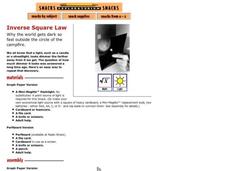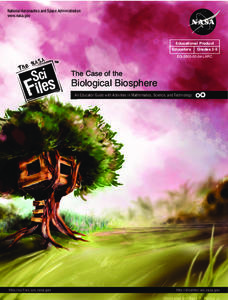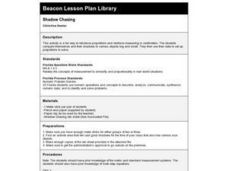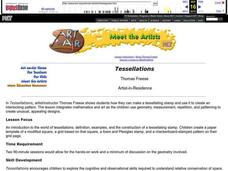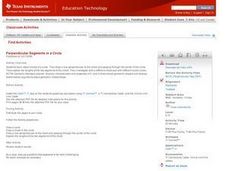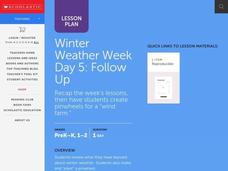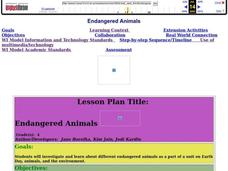Exploratorium
Inverse Square Law
The inverse square law is revealed when your class participates in this activity. They move a graph paper or perfboard square back and forth in a square of light to see how the intensity changes. You will definitely want to add this...
Curated OER
The Stained Glass Window
Students use centimeter rulers and the attached worksheet containing a scale drawing of a stained glass window. The actual measurements of the stained glass window are given, and students are asked to find the actual measurement of the...
Curated OER
TE Activity: The Beat Goes On
Students determine what the pulse is before examining how to measure the heart rate in different situations. They build a simple device that measures the heart rate, take heart rates, and record them on a worksheet. They discuss how...
Curated OER
Sea and Ice Salinity
Students conduct an experiment. In this salinity lesson, students learn about sea ice, why it is important and how changing amounts can affect the sea. Students conduct an experiment to find out the effects of salinity on the formation...
Alabama Learning Exchange
The Moon's Craters
Fifth graders investigate the formation and size of impact craters. In small groups, they conduct an experiment that involves dropping marbles into flour and measuring the impact from various heights and discussing their hypothesis and...
Curated OER
The Case of the Biological Biosphere: Health, Math, Technology
Students investigate various aspects of the human body in this imaginative Tree House Detective episode about the biological biosphere. In a series of They take measurements, analyze data, and use technology. The lessons revolve around...
Curated OER
Proportionality: Modeling the Future
Young scholars explore and examine how patterns, measurement, ratios and proportions are utilized in the research development and production of airplanes. They meet a pilot from the Federal Aviation Association who describes the growth...
Curated OER
Close Enough?
Students examine how navigation is based on mathematics and how making a mistake in measuring an angle could have an impact on a target. They observe a teacher-led lecture, use a calculator to complete two worksheets, and participate in...
Curated OER
Shadow Chasing
The students compare themselves and their shadows to various objects big and small. Students use their data to set up proportions to solve.
Curated OER
Property: Ownership, Respect, and Responsibility
Students learn to respect others' property by rating the severity of a variety of damaging acts. Students use a tag board "thermometer" to rate the severity of statements describing situations where a person damages the property of another.
Curated OER
Wind Power
Fourth graders develop an understanding of how engineers use wind to generate electricity. They will build a model anemometer to better understand and measure wind speed. They discover that engineers design wind turbines that generate...
Curated OER
Tessellations
Students learn and review basic geometric terms, definitions, and theory, including regular polygons, lines, angles, points, etc. They make a tessellating stamp and create a repeating work of art.
Curated OER
Asphalt Lab
Students are introduced to basic engineering principles, road construction and material science. They explore how material properties and strength can be affected. Students become Civil Engineers by both creating Asphalt cookies and by...
Curated OER
Perpendicular Segments in a Circle
High schoolers explore the concept of circles as they construct a circle using a program such as Cabri Jr. Learners construct a chord and a diameter that are perpendicular, then measure the bisected chord and notice that both sides of...
Curated OER
MuscleMania
Students learn three different types of muscles. By building a model of the arm, they learn its basic anatomy and how muscles function in relationship to bones. They perform an experiment on the relationship between muscle size and...
Curated OER
Winter Weather Day 5: Follow Up
Students participate in culminating activities for a winter weather unit. They discuss what they have learned about winter weather, and write a diamante poem using winter vocabulary words. Students also construct a pinwheel and explore...
Curated OER
The Emancipation Proclamation
Students explore the historical importance of the Emancipation Proclamation. In this United States History instructional activity, students use the internet to research the specific events that were centered around the Emancipation...
Curated OER
Endangered Animals
Fourth graders research different endangered animals in media center as part of unit on Earth Day, animals, and environment, create project based around multiple intelligence related to an endangered animal, and produce Powerpoint...
Curated OER
Arriba Amigos!
Students explore how culture effects our world. In this culture lesson, students work in groups to do a web quest. Students gather and analyze information to decide if Mayan ruins should be destroyed to build a shopping center. Students...
Curated OER
Rock Hunters
Students observe rocks of various types and sizes and record these observations through drawings. They gather rocks, measure, classify, observe, describe and record their collection.
Curated OER
Rainbows
Second graders investigate how a rainbow is made. They listen to the book "What Makes a Rainbow," and discuss how a rainbow is created. Students then conduct an experiment involving pouring a cup of milk into a bowl and adding drops of...
Curated OER
Globalization 101
Students explore the challenges created by cultural globalization. In this history lesson, students read several hand-outs centered on the topic, then participate in a class discussion and fill in a worksheet.
Curated OER
Jim Thorpe's Bright Path
Young scholars read about the life of Jim Thorpe and answer focus lessons about the book. In this Jim Thorpe lesson, students celebrate the American Indian culture and learn of the hardships Jim Thorpe overcame. Young scholars find...
Curated OER
Motion: Speed, Velocity, Acceleration and Networking
Students interpret a variety of motion graphs. In this physics lesson, students calculate the speed and acceleration of objects using numerical data from graphs. They apply what they have learned to solve real world problems.


